2023 Honda CR-V EX Review

FAST FACTS
| Engine: | 1.5L I4 Turbo |
| Output: | 190 hp, 179 lb-ft |
| Transmission: | CVT, AWD |
| US fuel economy (MPG): | 27/32/29 |
| CAN fuel economy (L/100KM): | 9.1/7.6/8.4 |
| Starting Price (USD): | $32,905 (inc. dest.) |
| As-Tested Price (USD): | $34,865 (inc. dest.) |
| Starting Price (CAD): | $36,190 (inc. dest.) |
| As-Tested Price (CAD): | $43,440 (inc. dest.) |
We couldn’t wait to drive the 2023 Honda CR-V. Literally.
Jump back to last summer. Under the mad genius of managing editor Mike Schlee, we here at AutoGuide rounded up 11 compact SUVs for the single biggest test of the year, covering the largest segment of the market. While the 2023 Honda CR-V had already bowed, the reality of press fleets and scheduling meant the outgoing fifth-generation model took part. Spoiler alert: it did not win, or even place on the podium.
SEE ALSO: Best Small SUV | Testing (Almost) Every Compact SUVWe had the sneaking suspicion the new model would have fared better. How could it not: Honda promised a better drive, more space, and a revised hybrid offering, after all. The latter in particular had us interested, but what about the “regular” drivetrain, the one more folks would be experiencing?
That line of thinking resulted in my spending a week with a gas-only 2023 Honda CR-V. The good news? This latest Honda SUV builds on the strengths that have made the CR-V such a critical and commercial juggernaut. The bad? It doesn’t bring anything new to the table, either.
(Editor’s Note: Keen-eyed readers will note right away that the CR-V tester pictured isn’t an EX, but a Sport trim. That’s because it’s a Canadian model; in Canada, the Sport isn’t a hybrid, and is roughly equivalent to the EX in the US. The main differences are visual.)
Get a Quote on a New 2023 Honda CR-V2023 Honda CR-V EX: What’s new?
For the sixth-generation CR-V, Honda has put the CR-V through the ol’ taffy machine, subtly stretching the SUV in nearly all directions. Length is up over two inches, to 184.8 inches (4,694 millimeters), and over half of that goes into the wheelbase (now 106.3 inches / 2,700 millimeters). There’s a half-inch (12 mm) increase across the CR-V, too.
Like someone discovering wide-leg pants, Honda has played with proportions here. Shifting the A-pillars rearward and introducing hard, horizontal lines around the body has resulted in a vehicle that is still recognizably CR-V, but with a more robust, upright, and altogether confident stance. This new model has already propagated all over the streets of Toronto, enough for me to confidently say it’s an improvement, at least to these eyes. The more angular take on the CR-V’s traditional pillar-mounted taillights is giving Volvo vibes—and the LED elements within look almost Mazda—but overall, I’d call it conservatively handsome.
Lower-trim models use an evolution of the familiar 1.5-liter turbo-four powertrain, in either front- or all-wheel drive formats. Get spendy and you’ll find a revised hybrid powertrain underhood—you can read our CR-V Hybrid first drive here, and expect a more detailed review on our home turf soon.
Welcome deja vu inside
Remember the German same-sausage-different-lengths approach to car design? Honda has taken that concept and applied it to its interiors. Starting with the Civic, each new Honda has featured a similar cabin layout: a long strip of mesh to cleverly hide the air vents, a trio of clickity-clack knurled dials for climate control duty, and a stand-up infotainment screen. What the CR-V’s interior design lacks in originality, it makes up for with a clean aesthetic, tight finishes, and generally high quality. The only exception to the latter is the cheapish matte plastic surrounding the shifter. That being said, I’d still rather that than piano black. Honda still uses the stuff, but it’s kept in places that won’t often see fingerprints and smudges.
The new model is wider than before, and this design only emphasizes that. The view out front is unobstructed widescreen, with the best sight lines this side of a Subaru Forester. Even the outgoing CR-V remained one of the most spacious offerings in the class, and this one carves out more space in all but one direction, for both rows. (That exception is rear headroom, which drops about an inch.)
Honda has redesigned the front seats for added comfort, and the work has paid off. The cloth seats are supportive, with good bolstering and just the right amount of cushion firmness. It’s the little things: Honda has reduced the steering wheel’s angle by three degrees (now 25 degrees) for a more comfortable, car-like feel. The result is less fatigue, even on the longer drives we take during the week.
Second-row passengers see an upgrade, too. The reduced headroom is barely noticeable, and there’s even more rear legroom now in exchange. The rear seats recline more than before, with additional steps and a higher maximum (10.5 degrees). Honda says the LATCH anchors are now easier to use, too.
Out in the cargo hold, there are no longer space differences between the gas and hybrid models. Both feature a cavernous 36.3 cubic feet (1,028 liters) of space, while certain models (EX and EX-L in the US) have an adjustable lower load floor for 39.3 cubes (1,113 L). That’s the case here, though it’s worth pointing out the uneven load space when you then fold the rear seats.
Happy handler
As the latest Civic proves, Honda still knows how to build solid everyday cars with the capacity for fun. The sixth-gen CR-V isn’t going to have you sniffing out the long way home each day, but it is near the top of the class for composure and responsiveness. The steering has a reassuring amount of weight, with smooth movement and consistent responses. It’s the same story for the brakes, which have a strong initial bite for confidence.
This latest generation has put on weight (now over 3,600 pounds / 1,633 kilograms), but it doesn’t feel wallowy or slow-witted. There’s a strong sense of solidity here, of reliable sure-footedness. Like the font of a good book, the CR-V does its job well precisely by not making you think about its job. For the vast majority of compact SUV buyers, that’s a win.
The tweaked, 190-horsepower 1.5-liter turbo-four puts in good work. Honda’s engineers have tuned it for an earlier torque peak, with the full 179 pound-feet now hitting at 1,700 rpm. Teeth may gnash at the mention of a continuously variable transmission (CVT), the only available transmission in the ICE CR-V, but it’s a good match for this powerplant. The ample torque means the CR-V doesn’t have to rev its little heart out to make quick progress. Highway passing oomph is less good, and does bring the noise. The AWD system was resolutely unperturbed by any of the wintery roads we threw at it—thanks too, winter tires—and the Hill Descent Control, new to CR-V this year, handled a snow-dusted trail with zero drama.
In America, the gas CR-V AWD’s official fuel economy figures are identical to the outgoing model: 27 mpg city, 32 mpg highway, and 29 mpg combined. That isn’t exactly the case: it’s slightly worse than before, as the more granular Canadian figures show (9.1/7.6/8.4 L/100 km, respectively). It’s important to note that we had no trouble matching that combined figure, and that was in the middle of winter, with ample snow coverage, on winter rubber.
Where’s the tech at?
Now admittedly, this tester is very much not the top-end CR-V trim. So we didn’t expect things like a 360-degree camera, head-up display, fully digital instrument panel, or ventilated front seats. Except no CR-V has those, even if most of its competitors do.
Even still, this CR-V feels almost austere, largely due to its ancient infotainment setup. The tiny 7.0-inch screen is laggy and prone to wash-out, and with no main menu, you’re left poking at the tiny buttons that run underneath it. (“Menu” is more accurately settings). The radio screen doesn’t even provide basic song information. Wired Apple CarPlay and Android Auto are both standard, and useful.
Thankfully, Honda doesn’t skimp on the safety features. Standard kit includes automated emergency braking, adaptive cruise control, lane-keep assist, rear-seat reminder, and back-up camera with dynamic guidelines. The latter is grainy, but serviceable; the ACC works well.
Our tester comes equipped with blind-spot monitoring and rear cross-traffic alert, too. They both impress, sensing vehicles from far away—further than a crowded parking lot typically allows for the driver, in the case of RCTA. These were both equipped on American 2023 CR-Vs at launch, but a recent rejig of the trims has seen both features locked to the top Sport Touring.
2023 Honda CR-V EX: Dollars and sense
This is where things get a little confusing, so we’re going to break the pricing down based on market.
In Our Home and Native Land where we tested this CR-V, this Sport AWD trim is the sixth step in an eight-trim walk—a lineup swollen by the entry-level LX split into FWD and AWD, with and without blind-spot monitoring. The most affordable choice is $36,190 CAD, while this model runs $43,440 CAD. In Canada, the top Touring trim is hybrid-only (and the only hybrid trim), at an eye-watering $50,840 CAD.
Down in America, the closest analog to this tester is the current “base” trim, the EX. Just swap out the black Sport wheels for regular alloys, and add the heated steering wheel—and AWD, of course. The final tally is $34,865, including destination.
That’s a lot of cash for an SUV that lags behind the pack in terms of features. For $35k you’re looking at a RAV4 XLE Premium.
Verdict: 2023 Honda CR-V EX Review
The 2023 Honda CR-V is the culmination of almost 30 years of refinement. It remains an easy-to-drive, capacious family hauler with on-road poise and increased in-cabin quality. This is, without a doubt, the best CR-V Honda has ever made, and it would have likely placed higher in our mega-comparison—just not enough to nab the title.
This segment has evolved too, and there’s a whole stack of strong competitors. Some drive nicer. Some are better equipped. Nearly all of them are better value. Honda faithfuls will glom onto this handsome new model in droves, of this I’m sure. But conquest buyers will be a tougher sell, as the high sticker prices need to be justified by the model’s reputation for quality and reliability.
FAQs
How much does the 2023 Honda CR-V cost?
The latest CR-V starts from $32,905 ($36,190 CAD), including destination.
Is the 2023 Honda CR-V bigger?
Yes, if only slightly. It grows 2.7 inches (69 mm) in length, with a 1.6-in (41-mm) wheelbase stretch.
Does the 2023 Honda CR-V come as a hybrid?
Yes, Honda once again sells the CR-V as a hybrid—including in Canada this time around—but only in higher trims.
Become an AutoGuide insider. Get the latest from the automotive world first by subscribing to our newsletter here.
LOVE IT
- Spacious interior
- General ease-of-use
- Refined driving dynamics
LEAVE IT
- Dated infotainment
- Comparatively high price
- CVT can still drone on the highway

Kyle began his automotive obsession before he even started school, courtesy of a remote control Porsche and various LEGO sets. He later studied advertising and graphic design at Humber College, which led him to writing about cars (both real and digital). He is now a proud member of the Automobile Journalists Association of Canada (AJAC), where he was the Journalist of the Year runner-up for 2021.
More by Kyle Patrick



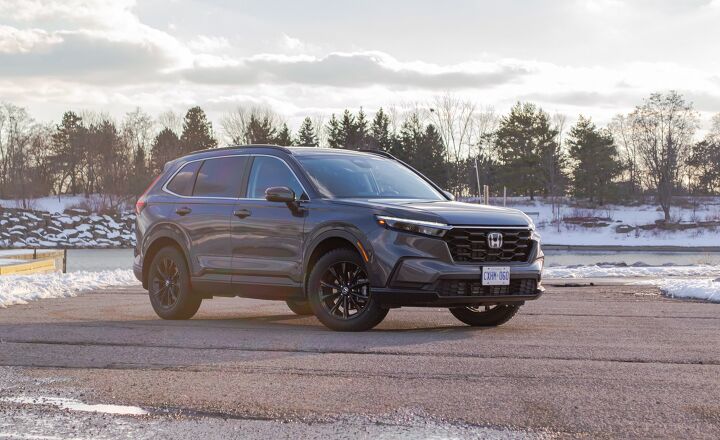
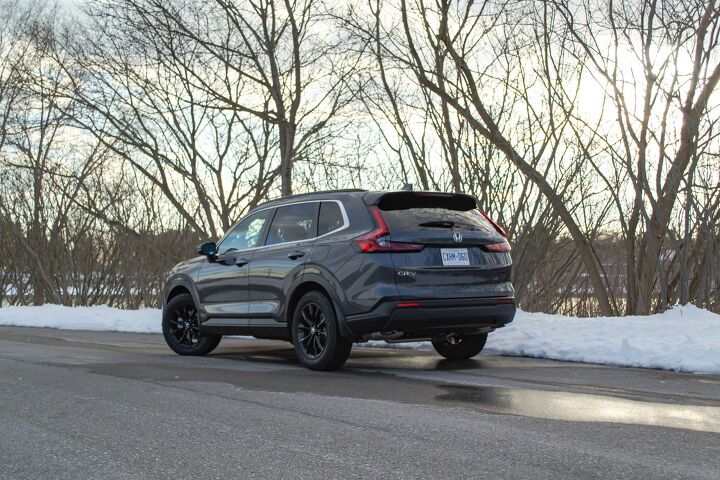






















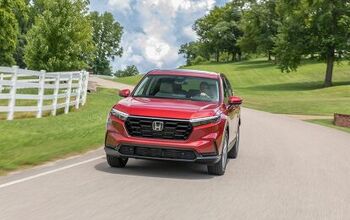

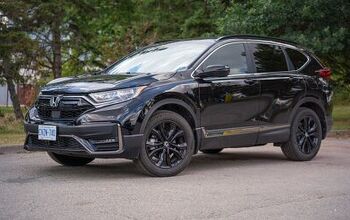
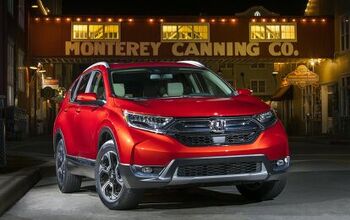



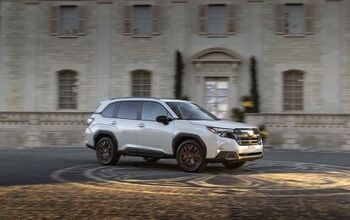


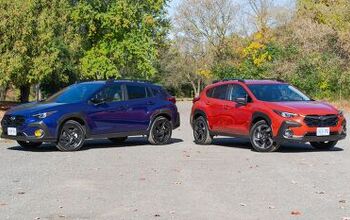
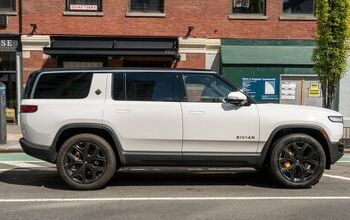
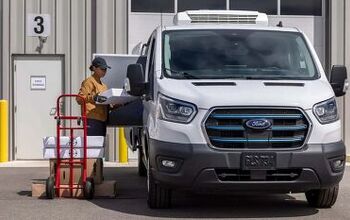

Comments
Join the conversation
Hendrick Honda does not have competitive pricing. They have $7000 in addiional dealer profit, including unneeded dealer installed options.